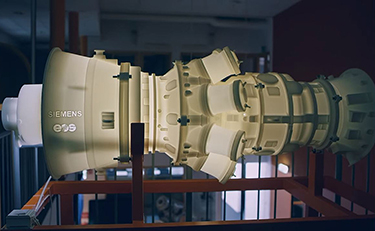The industrialization of additive manufacturing

Automation is digitally transforming manufacturing. What was once a costly, painstaking process of continual physical prototypes, trial and error, mass production and repeated processes, is now a dynamic, technological innovation of producing parts on demand via additive manufacturing, or 3D simulation. You can 3D simulate both the parts and processes before anything even prints.
Additive manufacturing technology is expanding rapidly.
With all this technology at your fingertips, it can be challenging to know where to begin. However, change is necessary to compete for speed, efficiency, demand, materials and design innovation.
Technology is a daily challenge, and sometimes what seems to be the most simple or straightforward part can make the most profound impact. For example, Siemens has experience with the production of small turbine blades, which may appear as a small part; however, “it is one of the most challenging applications in terms of metal additive manufacturing,” says Dr. Markus Seobold, Head of Additive Manufacturing at Siemens Power and Gas. “We not only print the existing 3D design of the turbine blade and test it, but we also change the design of the blade itself to improve performance of the part.”
Generating a prototype is easy; the difficulty is in achieving a physical part based on digital data. A defined process backs up your testing along with the standards and requirements for that part, such as gas turbine components – a necessary ingredient that is implemented into every project.
Additive manufacturing technology will change how we think about design. What was once impossible is now considered viable – designers and engineers need to understand this increase in design flexibility.
Moreover, this flexibility equates to real-world analytics, which displays radical efficiency. For example, the turbine blades deliver staggering performance: “(They) resist up to 1250 degrees Celsius, 1000 miles per hour and 11 tons of weight pulling at each blade. If you can print a turbine blade, you can print almost everything”, says Vladimir Navrotsky, Head of Technology and Innovation at Siemens Power and Gas Services.
The sum of these statistics show a:
-
- resulting 50 percent reduction in lead time,
-
- decrease of 75 percent in development time and
-
- performance of 13,000 rotations per minute.
The current manufacturing market promotes the synergy for an ongoing dynamic of nature and efficiency to power plants via the human engineer.
The collaboration of Siemens and EOS (Electro Optical Systems) improves productivity, manufacturing cost and value to each other in supporting the manufacturing industry.
Siemens is well-positioned to be the leader of the industrialization of additive manufacturing because it combines all necessary competencies. Their experts are successfully applying able skills to the materials and processes used to create high-tech products designed with Siemens NX, produced on EOS equipment, powered by automation technology and engineered and manufactured at Siemens Materials Solutions.
Learn more about this advancing technology – where today meets tomorrow.
About the author:
Blake Snodgrass is a writer for the Thought Leadership team in Siemens PLM Software, which supports several venues, including the Thought Leadership blog for the company. He speaks with experts in their field who provide compelling insight into innovative technologies affecting industries and how this can impact the future. Blake has a Bachelor of Arts degree in Mass Communications and more than 25 years of experience working for IT companies, with roles in technical writing, marketing communications, user-experience design and content development.


